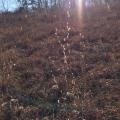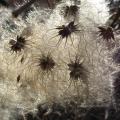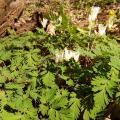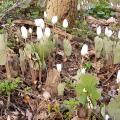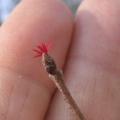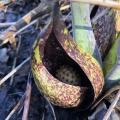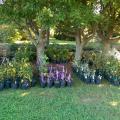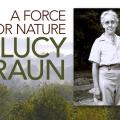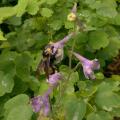By Sr. Leanne Jablonski, FMI, Ph.D., MEEC director
During this time of COVID-19 we find ourselves exiled from our normal life rhythms and supports, and our feelings of stress, anxiety and fear are inevitably heightened. We are grieving real losses and anticipating others, and suffering with the illnesses of loved ones and our inability to companion the dying. The struggle of springtime rains, with their hope of new greenery and lush flowers, to overcome the chilly winds of winter mirrors our internal struggle to maintain hope in our anxiety.
After a slow start, spring ephemeral season is moving very quickly now. Bluebells are finally beginning to bloom, and Dutchman's breeches are just about at their peak along with cutleaf toothwort, spring beauties, and violets. The last of the twinleaf blooms are fading, and the pipe-shaped seed pods are swelling.
The warm weather and rain have spurred a rapid progression in the spring wildflowers at MSJ. In just the past few days marsh marigold, bloodroot, spring beauty, false rue anemone and dutchman's breeches have started blooming. At peak bloom the marsh marigold will blanket the woodland fen in gold.
Last week we shared an image of honeysuckle starting to leaf out in the Marianist Nature Preserve, and compared it to our native trees and shrubs whose buds had not yet started to break. That doesn't mean our native woody species are dormant, however. Many of them are in bloom right now, but you may not know it unless you suffer from allergies.
The closure of public masses and other worship services has been for many of us one of the most painful consequences and deepest sacrifices of the C0ronavirus pandemic. During times of fear, tragedy and hardship our impulse is to turn to each other and the rituals that mark both the basic rhythms and the transitions of our lives.
Since we're not leading in-person hikes of the Marianist Nature Preserve this spring given the spread of COVID-19, we'll try to make more frequent posts here as the season progresses with observations from our staff.
As interest in native plants has grown, so has our nursery. Central to those efforts the past two years has been Peter Evans, a Marianist PULSE (Partners for Urban Leadership, Service, and Education) volunteer.
Controlled burning is one of the most effective strategies for keeping a prairie a prairie. Without the disruption fire provides, woody species would overtake the grasses and eventually a woods would stand where a prairie once grew. Fire also removes thatch, returning those nutrients to the soil, and controls early-season weeds. We conduct our burns in mid-March through early April, before the prairie species have broken dormancy, and when wind and humidity values are within a fairly narrow range.
Native seed collection is in full gear! We have plenty of opportunities for individuals or groups to lend a hand this fall.
A Force for Nature: Lucy Braun is a one-hour documentary that explores the life and legacy of E. Lucy Braun, one of the foremost botanists and ecologists in American history. Watch the trailer.
We're so grateful for all we accomplished as a community over the past year! This update was mailed to our Friends of MEEC members and supporters and summarizes our 2017 work and gives a peak at the year ahead. If you'd like to join our mailing list, click here.
The Bee Team surveyed bumble bees at Mount St. John during the summer of 2017. Here's what they found.
On August 7 our staff welcomed Peter Evans who joins us for the next year as a full-time volunteer with the Marianist PULSE program.
- ‹ previous
- 2 of 3
- next ›




